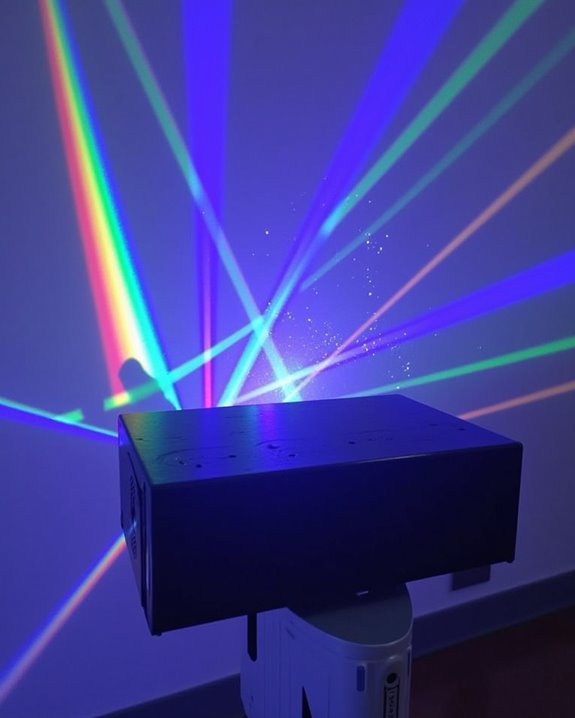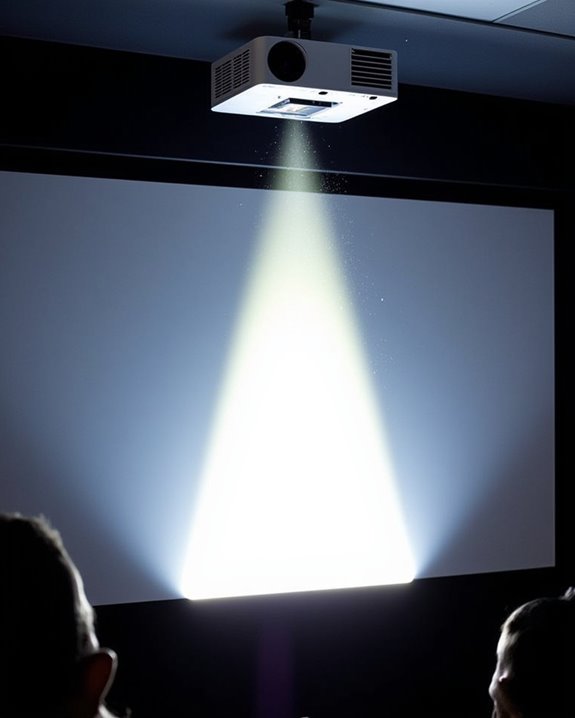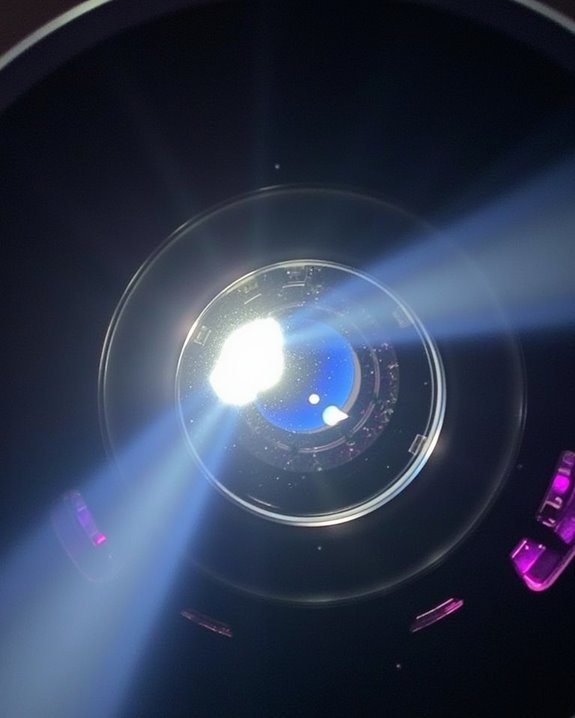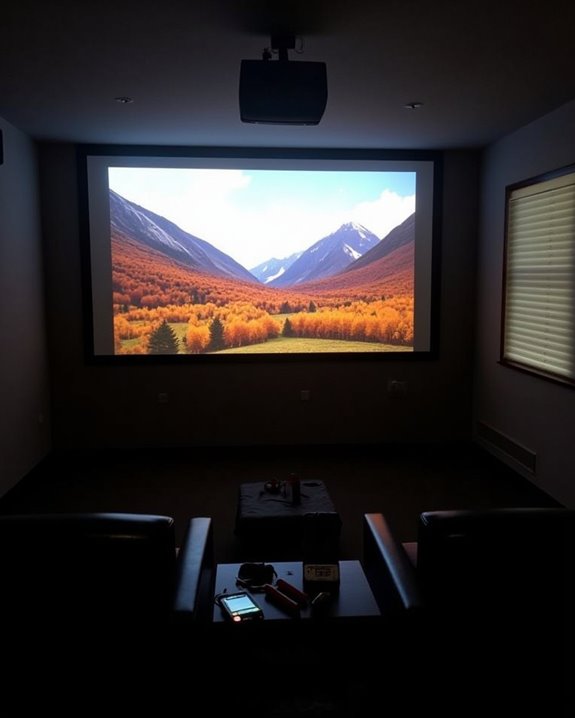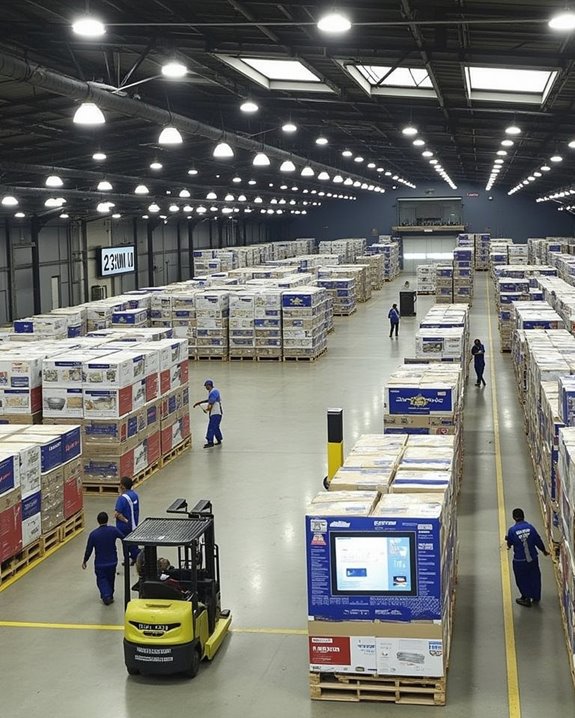Like the evolution from candlelight to electric bulbs, laser data projectors represent a technological leap in visual display technology. You’re probably familiar with traditional projectors, but laser systems offer a revolutionary approach to image projection. These devices use precise laser diodes to generate vivid colors with unprecedented brightness, contrast, and longevity. While standard projectors rely on lamps that dim over time, laser technology maintains consistent performance for 20,000+ hours. The applications extend far beyond basic presentations, transforming industrial workflows and entertainment experiences in ways you’ll soon discover.
Key Takeaways
- Laser data projectors use red, green, and blue laser diodes to create bright, high-quality images with superior color accuracy.
- Unlike traditional lamp projectors, laser systems offer longer lifespans (up to 20,000 hours) and require minimal maintenance.
- They provide consistent brightness, higher contrast ratios, and quick startup times for professional environments.
- Laser projectors come in RGB (premium) and phosphor (cost-effective) varieties for different commercial applications.
- They excel in ambient light conditions and offer energy efficiency with lower total ownership costs despite higher initial investment.
The Evolution of Laser Technology in Projectors
While modern laser projectors represent cutting-edge display technology, their development has followed a fascinating journey spanning several centuries of optical innovation. The laser history begins with projection concepts dating back to Leonardo Da Vinci’s sketches in 1515, but true advancement came when Thomas Edison invented the first practical projector in 1984.
A significant breakthrough occurred in the 1960s when gallium-arsenide semiconductor lasers were developed simultaneously by research teams at GE, IBM, and MIT. These projection advancements, combined with optical pumping techniques, laid the groundwork for what would become laser projection. Though early laser TV prototypes emerged in 1995, high costs limited commercial viability until the 2000s, when semiconductor laser technology finally made laser projectors accessible beyond specialized professional applications. Modern laser projectors often incorporate high refractive glass lenses and advanced image processing to deliver superior image quality and brightness suitable for various environments.
How Laser Data Projectors Work: Core Mechanisms Explained
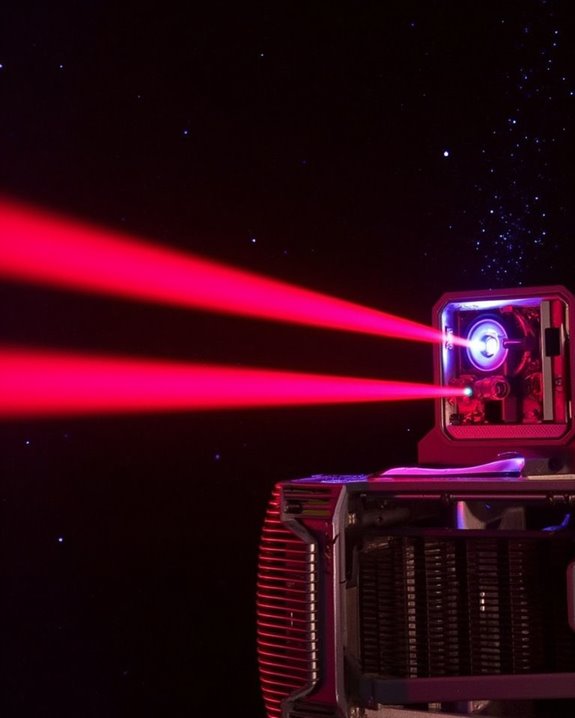
At the heart of today’s advanced projection technology, laser data projectors operate through an intricate interplay of optics, electronics, and precision engineering that revolutionizes how we experience visual presentations. You’ll find these systems use laser diodes emitting coherent light in primary colors (red, green, blue), which then travels through sophisticated modulation technologies like DLP, 3LCD, or LCoS to create images. The optical path directs these beams through dichroic mirrors and prisms, ensuring proper color calibration for vivid, accurate reproduction on your screen. Unlike traditional lamps, lasers don’t require filtering through color wheels, improving efficiency and color purity. Throughout this process, laser safety measures remain paramount, with protective housings and sensors preventing accidental exposure to the high-intensity beams that make this superior image quality possible. Modern laser projectors often consume less power than traditional lamp-based models, contributing to lower power consumption and enhanced environmental efficiency.
RGB vs. Phosphor: Different Types of Laser Projection Systems
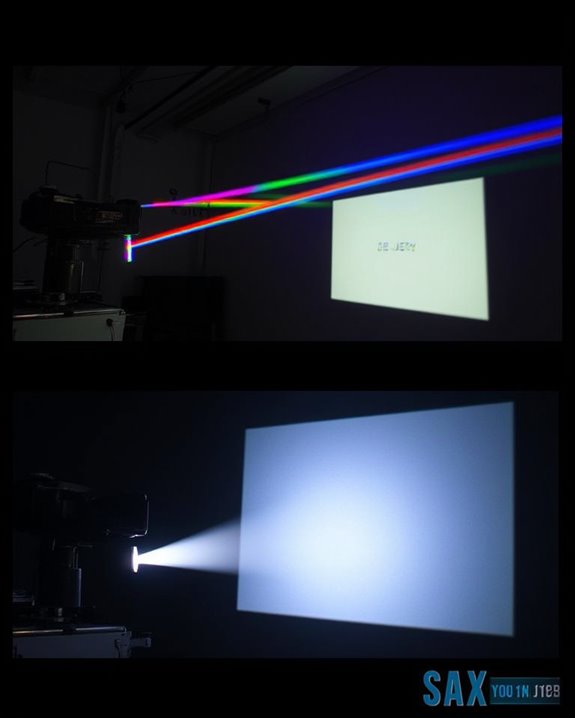
When comparing laser projection technologies, you’ll discover two distinct approaches that define today’s market: RGB and phosphor laser systems. RGB projectors utilize separate red, green, and blue laser diodes, enabling precise color reproduction and an exceptionally wide color gamut. This technology excels in high-end applications where color accuracy is paramount, though it typically comes with higher costs and more complex engineering.
In contrast, phosphor laser projectors employ a single blue laser with a phosphor wheel to generate other colors, offering superior cost efficiency for commercial environments. While phosphor systems may not achieve the same level of color precision as their RGB counterparts, they provide an excellent balance of performance and affordability. Your choice between these technologies will depend on whether you prioritize ultimate color reproduction or operational economy. Additionally, advancements such as quantum dot technology are increasingly integrated into display systems to enhance color accuracy and brightness.
Key Benefits of Laser Projectors in Industrial Settings
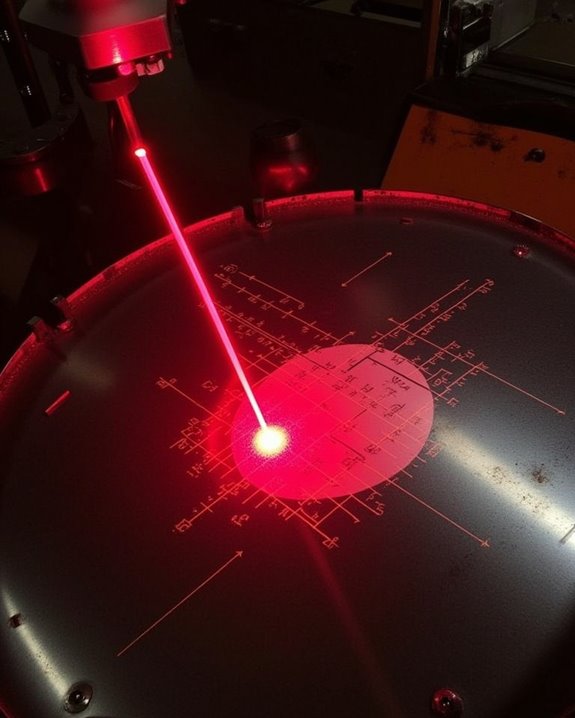
Laser projectors have fundamentally transformed industrial manufacturing processes, offering unparalleled advantages that extend far beyond traditional projection technologies. You’ll achieve substantial cost savings by eliminating physical templates, reducing layout time by 50-75%, and minimizing rework costs by up to 100%. These systems enhance quality enhancement through precise visual guidance, ensuring consistent assembly across production lines while dramatically reducing error rates and scrap materials.
Your operational flexibility improves markedly as engineering changes can be implemented instantly without creating new physical templates, freeing valuable floor space and reducing inventory needs. The long-term benefits include lower energy consumption compared to lamp-based systems, reduced training requirements for operators, and improved throughput across complex manufacturing tasks like 3D assembly and composite layup processes.
Comparing Laser Projectors to Traditional Lamp-Based Systems
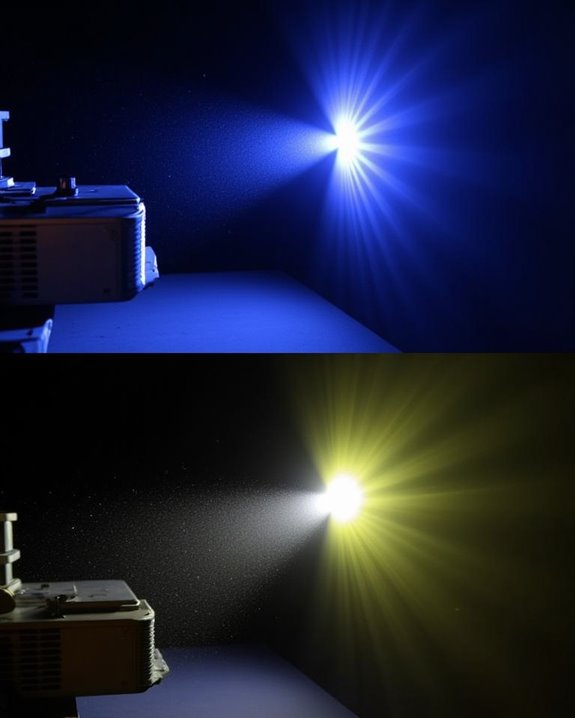
Understanding how laser projectors compare to their traditional lamp-based counterparts helps you make informed decisions about which technology best suits your manufacturing needs. Laser projectors offer superior brightness that maintains consistency for up to 20,000 hours, while lamp-based systems typically require bulb replacements after just 2,000-10,000 hours, considerably increasing maintenance costs over time.
You’ll notice remarkable differences in color accuracy as well, with laser technology providing richer, more saturated colors due to their wider color gamut. In environments with ambient light, laser projectors perform notably better, making them ideal for industrial settings where lighting cannot be controlled. Though laser systems demand a higher initial investment, their reduced downtime, minimal maintenance requirements, and exceptional durability usually result in a lower total cost of ownership throughout the projector’s lifespan.
Real-World Applications Across Manufacturing Industries
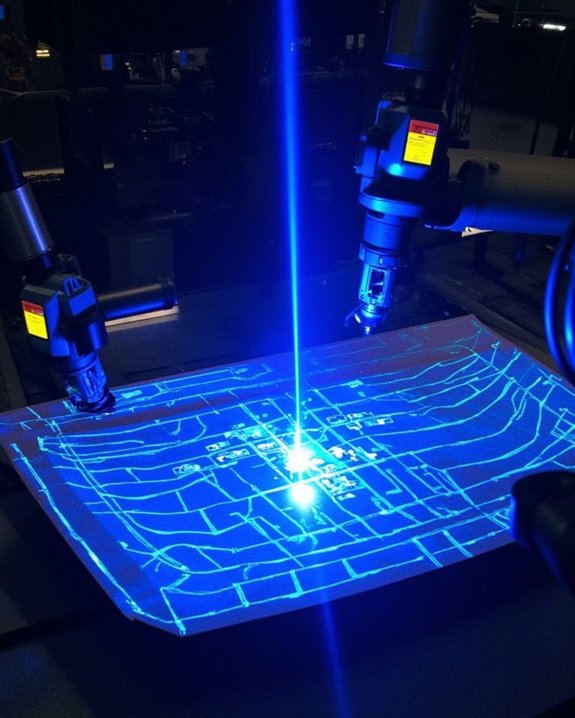
Across diverse manufacturing sectors, you’ll find laser data projectors revolutionizing production processes through their unparalleled precision and versatility. In aerospace manufacturing, these systems guide the precise positioning of aircraft components, while wind energy producers use them to align massive rotor blade elements, markedly reducing environmental impact through minimized material waste. You’ll see similar applications in automotive, woodworking, and construction industries, where digital templating replaces physical templates.
Cost analysis reveals substantial long-term savings, as these systems eliminate expenses associated with creating, storing, and replacing physical templates. Additionally, manufacturers report increased productivity when workers follow the clear visual guidelines projected onto work surfaces. The integration with CAD systems further enhances efficiency by allowing direct projection of digital designs onto various surface types, flat or curved.
Future Innovations and Emerging Trends in Laser Projection
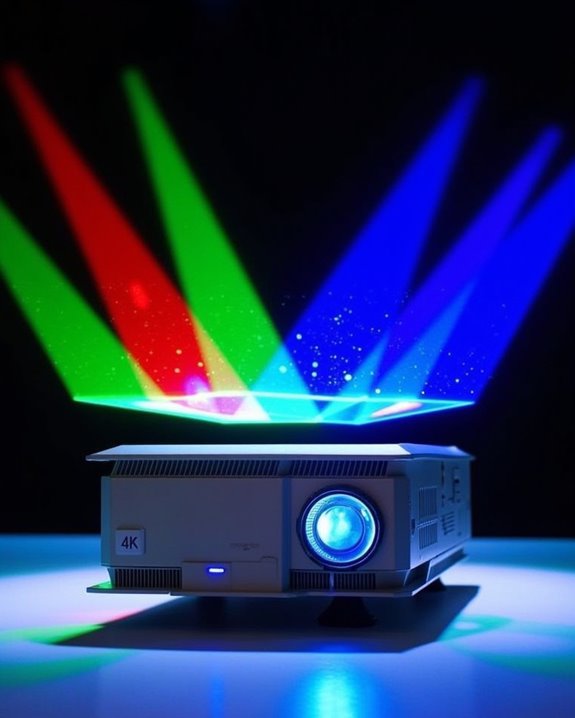
As we look toward the horizon of laser projection technology, you’ll notice several groundbreaking innovations poised to transform this already versatile tool. AI integration is revolutionizing the user interface, enabling smarter setups with automatic adjustments for brightness and contrast based on environmental conditions. Triple laser technology and High-Efficiency-Pixel DMD are dramatically enhancing image quality, delivering more vivid colors even in well-lit spaces.
Market adoption is accelerating as projectors incorporate voice control features and ultra-short throw capabilities, making them more accessible and space-efficient. You’ll find that miniaturization trends are creating increasingly portable options while maintaining powerful performance. Smart connectivity, including Google TV integration and seamless multi-device pairing, is expanding content access. These advancements, coupled with AI-powered personalization, are creating projection systems that anticipate your needs before you even reach for the remote.
Frequently Asked Questions
What Is the Average Lifespan of a Laser Data Projector?
Like Methuselah among projectors, your laser data projector will typically last 20,000-50,000 hours (7-12 years with daily use). Proper projection maintenance considerably extends laser lifespan beyond traditional lamp models’ mere thousands of hours.
Can Laser Projectors Operate Effectively in Brightly Lit Environments?
Yes, you’ll find laser projectors perform well in brightly lit environments. Their high ANSI lumens (6,500+ in Panasonic models) maintain image contrast despite ambient lighting challenges, making them ideal for classrooms and conference rooms.
Are Laser Projectors Harmful to Human Eyes During Operation?
Laser projectors aren’t harmful if used properly. You’ll be safe during normal operation, but don’t look directly into the beam. For eye safety, maintain distance and take breaks to minimize laser exposure risks.
How Much Power Do Laser Projectors Typically Consume?
Laser projectors typically consume several hundred watts to 6+ kW, depending on brightness. You’ll find high-lumen models have higher power consumption, though newer technologies like ALPD offer improved energy efficiency for your projection needs.
Can Laser Projectors Be Networked for Multi-Location Synchronized Projections?
Did you know 85% of enterprises now use multi-location presentations? Yes, you can network laser projectors for synchronized projections across sites. Network synchronization and multi-site integration enable seamless coordination with minimal latency between locations.

